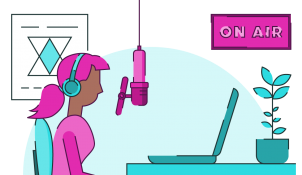As an eLearning content creator, I’m always on the lookout for ways to create more effective eLearning. And I’ve learned a lot from reflecting on my own failed attempts at learning something new. So, let me open up to you about a recent learning failure, and use it as a lens to see how we can all improve the learning experience for course users.
My most recent foray into learning things took the form of a physical challenge. I took myself over to YouTube and found a 10-minute video that promised viewers everything they needed to perfect a full split in just 30 days. I wanted to get a bit more flexible and was excited by the prospect of achieving my goal in just one month’s time.
How did it go? Reader – I got to day six and didn’t budge an inch!
So, what went wrong? What was so complicated about doing 10 minutes of yoga stretches every day that I could only manage six days before throwing in the proverbial towel?
Well, three key elements of effective eLearning were missing from this splits challenge, meaning I was doomed to fail before I even started.
Creating effective eLearning: Variety
A major issue with this challenge was that it required me to follow the same 10 minute video every day. I enjoyed the repetition at first but, over time, it got boring as the exercises didn’t give quick enough results.
Most of us – be us yoga enthusiasts or instructional designers – agree that routine is good. But there’s an inherent risk to starting a new routine, as if you get bored before a certain point, you won’t commit to making the change long-term.
Similarly, it’s uncontroversial to say that repetition has its place in any kind of training. Of course, we want to create a consistent experience for learners, and using parallel structures (for example, watching a video then completing a quiz question) throughout the training has its merits. Learners won’t have to figure out what they need to do every time. But you can’t expect learners to stay engaged if they’re repeatedly seeing the exact same content.
Meaningful variety is a key part of successful eLearning. Consider the medium, question type, or interaction style that works best for each piece of the eLearning content you are creating. You’ll likely find that different methods will work best for different parts (or chunks, if you want to use a bit of industry jargon) of the content. This way you can give your learners the variety they crave and use the most effective eLearning techniques for each thing you need to teach. For some inspiring ideas of varied interactions to create in your eLearning, check out our Storyline interaction resource.
Creating effective eLearning: Structure
Another issue with the repetitive nature of the splits challenge was that I had no sense of progression or completion. There were no quick wins – I couldn’t do the splits on day one and would have had to persevere until day 30 to see if I could get there!
Even if your learners are going into training with a positive attitude and intrinsic motivation – like I was with the splits challenge – it’s really difficult to maintain that excitement and energy if progress isn’t recognised.
Consider how your content builds on what learners already know. Effective eLearning should start with something easy – something within learners’ wheelhouse – and get progressively harder from there. Starting with an easy win for your learners instils a sense of positivity from the offset, which encourages them to keep going.
You also need to make it easy for learners to track their progress. Have learners complete periodic quizzes, unlock different levels of training as they move through a course, or enable them to reflect on their journey using breadcrumbs, badges, or progress bars.
Creating effective eLearning: Stakes
The nail in my splitty coffin was that if I didn’t get up at 7am to practice, no-one was going to notice – let alone call me out for it. There were literally no consequences for not being able to do the splits in 30 days.
If your learners don’t feel that there’s any consequences for or benefits of doing the training, it isn’t going to make for a very effective eLearning course. But I’m not encouraging you to increase your surveillance or punish learners who don’t pass eLearning tests! Often, clear communication is all it takes to improve this facet of training content.
You might think it’s obvious why training is needed, but your leaners might not share this view. Be sure to make it clear to learners what the consequences are for not completing the eLearning. What are the safety risks? What are the opportunities they’ll miss? Communicate the benefits as well: how will the training help learners in their day-to-day lives?
This will make the eLearning seem a lot more relevant to learners, which in turn makes the content a lot more memorable; we tend to remember things that we perceive as relevant much better than things we don’t perceive in this way.
You can learn more about creating compelling training content in our Better Training Presentations resource, or repurpose some of the ideas from the world of sales messaging to craft a persuasive eLearning course.
So, there we have it – three essentials for effective eLearning. These aren’t necessarily simple fixes you can retrofit into your existing projects, but fundamental principles that should change the way you develop eLearning content – for the better!
And as for me and the splits, I’m going to do some more research and find a progressive and varied learning plan with some stakes to make sure I keep at it!
Leave a comment




